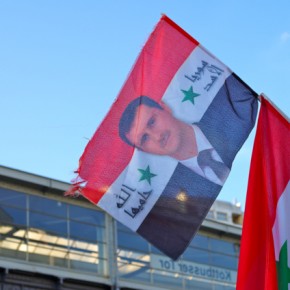It was great revolutionary branding. A beautiful young woman, wearing a Turkish star and crescent teeshirt, was holding up a matching flag, blowing in the evening wind. Her eyes were focused on something afar, as though preoccupied with higher thoughts – of the good of the nation, perhaps. Three women stood to her right. One sported a similarly coordinated Turkey-branded teeshirt and headband, while two others, likely ethnic Germans, appeared captivated – one by the flag, the other by the proceedings.
The second Occupy Gezi solidarity demonstration to take place in Germany’s capital city in as many days, Berlin’s Kotbusser Tor intersection was swamped with protestors. “Three to five thousand,” said my friend Matt, a British journalist, who had originally alerted me to the event. Using my pocket camera’s panorama function, I attempted to capture the breadth of the crowd that had gathered on Kotbusser Tor’s southeastern corner.

For a movement that had been tagged with pejoratives such as capulcular (“riff-raff,” in Turkish) and “extremists,” by their conservative Prime Minister, Recept Tayyip Erdogan, this was a surprisingly middle class-looking, well-dressed lot. Not a dreadlocked anarchist, nor a hijab in sight. What was especially noteworthy, was the extremely heavy presence of women. As per the lead photo, from what I could see, secular young and middle-aged women constituted at least half of the protestors in attendance. At least amongst those in my immediate vision.

As a seasoned demo goer, the gender balance was especially striking. Like punk gigs, in my experience, political protests, particularly of this nature, tend to be heavily dominated by men. Especially in recent years, at the anti-austerity protests I’ve attended, in several different European cities, as well as in the United Kingdom. There’s always a high testosterone count in the air, which is oftentimes so thick, you can cut it with a knife. The vibe, as it were, was entirely different here. Charged, for sure. But not a hint of violence.

The revolutionary face put forward by the protestors, however, was male. That of Mustafa Kemal Ataturk, to be precise, the founder of modern Turkey. Though best known for his initiation of European-style secularism in the country, Ataturk was also a supporter of women’s suffrage, granting women the right to vote in 1934. Though power in the country remained largely held by men, 18 women were voted into parliament the following year. That sort of breakthrough is not easily forgotten, particularly in light of Erdogan’s recent attempts to reinstate headscarves in public spaces, such as universities, following their constitutional banning, in places of work, by the late Ataturk.
Though no authority on Turkish history or culture, even a superficial familiarity, at political events like these, can yield all sorts of interesting questions about the country. Just the sort, I fear, that I have not immediately encountered in coverage of the protests that I’ve read. Still, living in a heavily Turkish part of the city (the neighboring borough of Neukolln) and hailing from an Israeli family that once lived under Ottoman rule in Palestine (my paternal grandparents and great-grandparents) I feel somewhat close to it all, however nationally removed. One cannot help but feel sympathy towards my neighbors’ political struggles. Especially when they’re so obviously distressed.
– Joel Schalit. Photographs courtesy of the author.





